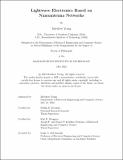Lightwave Electronics Based on Nanoantenna Networks
Author(s)
Yeung, Matthew
DownloadThesis PDF (21.10Mb)
Advisor
Keathley, Phillip D.
Berggren, Karl K.
Terms of use
Metadata
Show full item recordAbstract
The evolution of commercial lasers has played a pivotal role in advancing our comprehension of the natural world. Emitting coherent, high-intensity light, lasers offer unparalleled capabilities, reaching peak intensities of terawatts per centimeter squared at frequencies exceeding a million times per second. Such immense peak intensities facilitate electric field amplitudes at the focus that scale to the V/nm range, rivaling the electric field strengths within atoms and molecules responsible for atomic-scale electron dynamics. Through the realm of ultrafast nonlinear optics, the manipulation of optical waveforms has paved the way for controlling electrons at optical frequencies [1]–[7]. This breakthrough has led to a deeper understanding of electron dynamics, particularly in the context of light field-driven phenomena in solids, a field commonly referred to as lightwave electronics.
As traditional semiconductor electronics approach their saturation limits in terms of speed and size, researchers are turning to light as a means of encoding information, ushering in the era of integrated photonics. Light, with its minimal absorption and high data propagation rates coupled with low power dissipation, offers an ideal medium for transmitting information. While integrated photonics encodes information within the time-averaged intensity and polarization of light, the harnessing of ultrafast electric field oscillations in light, analogous to the behavior of modern-day high-speed electronics, presents an opportunity to encode information in the sub-cycle field oscillations. In pursuit of electronics operating at optical frequencies, various methods have been explored to realize practical lightwave electronic circuit elements analogous to those in traditional electronics. Pioneering experiments have showcased that optical waveforms can initiate attosecond electron currents across various interfaces, encompassing metal-vacuum [8]–[17], dielectric [18]–[20], and air interfaces [21], [22]. However, a significant hurdle arises from the difference between the characteristic frequencies of optical (PHz) and electronic systems (GHz-THz), making it difficult to integrate optical systems with electronic ones.
This thesis underscores the pivotal role of metallic nanoantennas as a scalable platform for lightwave electronics. It demonstrates how metallic nanoantennas enable control over light field-driven responses through rectification, resonance control (leading to lower peak fields required to operate), and polarization control. A comprehensive framework is introduced, serving as the backbone for subsequent chapters. The thesis showcases three nanoantenna variants: one facilitating shot-to-shot measurements of PHz optical phase on a chip, yielding over 2000 optical phase-sensitive electrons, ideal for compact optical waveform synthesis and interferometry-free frequency combs. When leveraging rectification, the thesis further illustrates harmonic frequency mixing with bandwidth surpassing that of the input light, enabling the direct detection of PHz frequencies using multi-cycle light from commercial laser systems. This practical demonstration facilitates frequency mixing, positioning the device as a compact detector for optical oscilloscope-like measurements. Finally, an architecture is presented to enable polarization-sensitive rectification, highlighting the flexibility of the nanoantenna platform for PHz-driven electrons.
As is exhibited through the work in this thesis, nanoantennas possess the potential to emerge as a comprehensive solution for lightwave-driven electronics, enabling a new era of high-speed, low-power electronic systems driven by oscillations of light.
Date issued
2024-05Department
Massachusetts Institute of Technology. Department of Electrical Engineering and Computer SciencePublisher
Massachusetts Institute of Technology